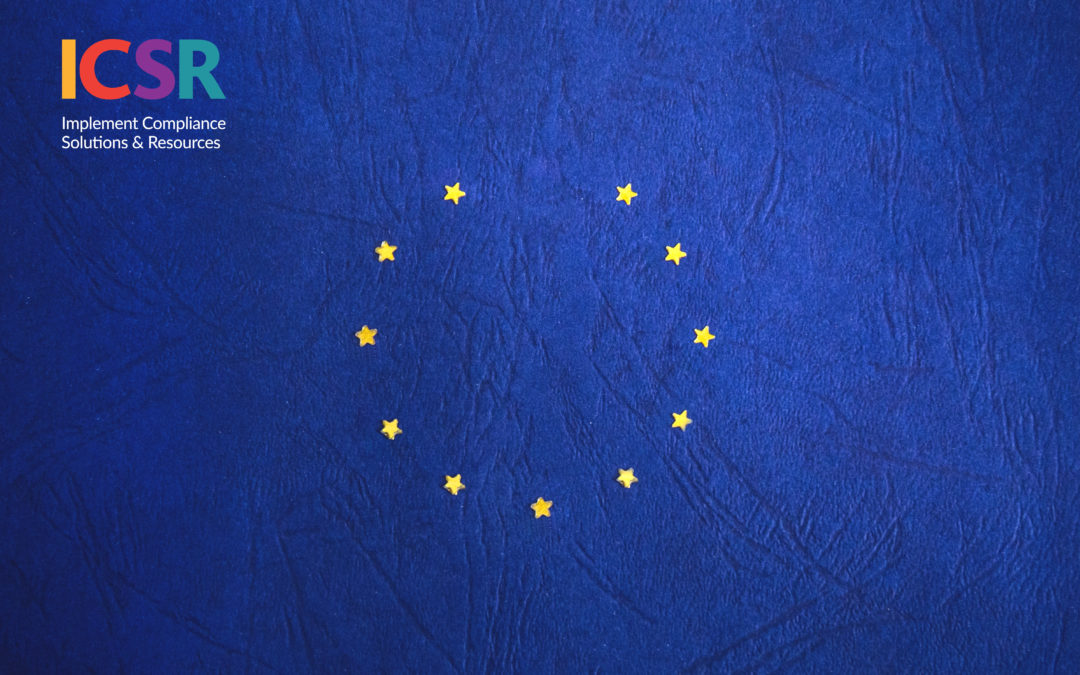It is time to look at the realities of the UK’s vote to leave the EU
It is time to put the hype and hyperbole aside and look at the realities of the recent vote. Many, if not all of the large companies will have included Brexit on their risk registers and some will have been thinking or planning for the possibility. There are several years before Brexit occurs, if according to some of the debate, it happens at all.
What does it mean for regulated businesses going forward?
Businesses in the EU, including the UK for the moment have the right to trade in other EU countries on a Freedom of Service (FOS) or Right of Establishment (ROE) basis. Trading on the basis of FOS and/or ROE is known as “passporting”. FOS permits a company in one country to sell its products direct to consumers and commercial customers in another EU country. ROE permits a company established in one EU country to sell its products to consumers and commercial customers in another EU country through a branch in that other EU country. This means that at present a UK insurer can have branches in each EU country without the need to have a separate legal entity or hold capital in the countries where it has a branch. In both cases no additional license is required, the regulator in the EU country merely needs to be notified. If a company does not trade across Europe on an FOS or an ROE basis the impact from an immediate legal point of view is minimal.
A UK insurer can currently offer its multinational customers one insurance policy to cover all their risks across the EU without needing to have any legal entity and/or capital in each country where their customer has risk that it wishes to mitigate with insurance. The Policy covering all a customer’s commercial risks could be issued in London and based on English law and English jurisdiction.
However companies offering products direct from the UK to EU customers or vice versa or from a branch in an EU country are very likely to be impacted in terms of how they distribute their products and in what licenses they need will need to hold. This is because it is likely the passporting system will be lost as regards trading between the UK and other EU countries both inwards and outwards. Distribution is dependent on the legal structure and licenses and this drives the need to consider what appropriate legal structure should be adopted. There are cost implications which have a negative impact but this also presents an opportunity to review corporate and tax structures and possibly create greater efficiencies for the future.
Regulated entities need to consider now what steps they should be taking to prepare for these changes.
Next Steps
There are a range of immediate, short term and longer term steps which should be taken by companies which may be impacted. The following is an inexhaustive list. Priority is dependent on individual circumstances and in particular what planning has already taken place.
Step 1. A company needs to determine whether it has any products which are distributed under the passporting system and if so whether by FOS or ROE and by which of its trading companies. If so, identify the impact of this. Is it significant? Can the business trade and grow profitably without these products and customers or is EU growth a part of the long term strategy?
Step 2. Consider the significance of the impact. Do regulators, shareholders or material investors need to be informed or consulted. This question may not necessarily be a legal issue. Listed businesses may wish to inform shareholders early of their position and what they are doing to mitigate any issues. Is it possible that banking covenants could be affected? What other financial arrangements may be impacted? At the same time thought is required about management of customer communications and expectations. Customers in the EU will not doubt be interested to know what their UK insurers are intending to do.
Step 3. If there is an impact a working party should be established. Depending on the size of the organisation and the impact you may wish to involve individuals from the business, Legal, Compliance, Risk, Finance, IT, Operations, and Human Resources. I have set out later in this paper some of the issues which need consideration and why each may be necessary. Because key decisions may depend on a number of interlinked issues it is key that the working party is inclusive and work collaboratively. The alternative may result in key decisions being made without all of the necessary information.
Step 4. Determine the scope of the working party’s responsibilities and if necessary record these in a terms of reference or other scoping document. This should include the stages required. Commonly this would start with a due diligence exercise to determine what is affected, identify proposed structures (often presented as alternatives) and then execution. Appoint a leader. Consider whether that leader may be appropriate for all stages of the transaction.
Step 5. Set up an appropriate reporting structure for the working party to ensure good corporate governance. Should the leader report to the CEO, any Executive Committee or the Board? The working party may be considering issues which could have an impact on what staff are required and where or other material changes to their working conditions so ensure that legal advice is obtained about how to ensure decisions which would trigger the requirement to consult with staff are not made prematurely. It is good practise to also label all documents appropriately as being prior to any decisions being made. It is also important that the CRO is engaged in reviewing the proposals to determine the risks and potential mitigants and thus be in a positon to advise the Board accordingly.
Step 6. Consider a timetable of some sort. The likelihood is that a withdrawal from the EU will take at least two years once the government has triggered the process. It is possible that it may take longer and that interim measures are agreed as a part of the withdrawal but this cannot be taken for granted. Business is transacted utilising the passporting system, (EU business written by an insurer in the UK or UK business written by an insurer or branch in an EU country) may have to be transferred under the provisions of Part VII of the Financial Services and Markets Act out of or into the UK as appropriate. This also applies whether or not the company is retaining the business and transferring it to its own EU based legal entity or selling it to a third party. An alternative which may be possible is the transfer of renewal rights to an EU authorised insurer. This will still require appropriate consideration (payment) be made and there are likely as a minimum to be tax and capital implications.
Portfolio transfers under Part VII can take 12 or so months after due diligence has been completed and a basic legal structure has been decided upon because they require the consent of the UK regulators, the regulators in the country where any customers are based and most often the customers must be notified. Many will also require the approval of the UK courts. Historically, the speed at which a transfer can be undertaken is dependent on the regulatory timetable. A note of caution here. While the Chancellor of the Exchequer has made the statement that the regulators have planned for a possible Brexit and this may be true, there is no evidence that they are or will be ready for the likely number of Part VII’s which may be required in a very short period of time. In recent years the regulators were so busy preparing for Solvency II that they effectively informed businesses that they would take no more applications for Part VII transfers. It is likely that it will be first come first served basis so businesses which have not planned for Brexit or undertaken their due diligence at this point in time are already going to be behind the game. Early notification to your regulator of the possible need for a Part VIII transfer is essential.
Step 7. Determine what external assistance may be required and whether project management support is required. As with the regulators this is going to be a very busy time for lawyers, accountants, tax and restructuring advisors. The process can be difficult and it is best to consider using those with a proven track record.
Step 8. Identify and appoint an actuary. In many countries regulators and where appropriate courts require an independent actuarial report which considers the impact of the transfer of business on the policyholders. There is a limited number of actuaries with the necessary expertise and experience. Often they will work for one of the Big 4 which often limits the choice of an independent actuary so speed is of the essence.
Step 9. If there is pan-EU business written on an FOS basis (whether in the UK or in branches or legal entities in any EU country) there is a need now to commence replacing the pan-EU products with separate EU and UK products for each customer as the policies renew. Brokers and insurers will want to ensure their mutual customers are covered with two policies, one of which covers the UK elements of a customer’s risks and a separate one for the customer’s EU based risks. This will make it easier, (and less disruptive for customers) in the longer term when it comes time to restructure the legal entities of the insurer who will be required to transfer the underwriting of any EU business out of the UK and any UK risks written by a branch or legal entity in the EU into a UK regulated entity.
Licenses and Legal Structures
Unless a decision is made to place passported business in run-off (for which a license may still be required – the position is uncertain) or to sell it (which may still require a Part VII Transfer and/or renewal rights transfer), post-Brexit product distributors, whether they be a product provider or an intermediary, will need to be licensed in the EU to undertake regulated activities relating to the provision of those products in the EU, their distribution or the ongoing support for those products. Likewise European insurers will need to be regulated in the UK for the provision of products they offer customers in the UK.
However, there is no “one size fits all” solution as to what structure is best.
The question also has to be asked about which EU country is the appropriate place for a European headquarter for EU business. There are many factors which come into play here and often it will be dependent on what operations already exist and the financial, particularly tax, implications of each. The various considerations are often interlinked and include financial, tax (corporate, transactional and employment related), regulation, availability of suitably qualified staff, accessibility and geopolitical stability. Some considerations which may come in to play are outlined below.
Type of Legal Entity and Structure
There are two ways for UK insurers to meet their obligations if they want to retain the business rather than sell it to an EU based insurer. Be licensed in each EU country which is costly and inefficient, or be licensed in one country and utilise the passporting system for the other EU countries. Utilisation of the EU passporting system is not lost to a UK entity once it has a license in an EU country. For an insurer there is a significant advantage to having only one underwriting platform in the EU rather than several or more. That is the need for capital under the Solvency II regime. One EU entity with business written in a number of EU jurisdictions means a greater opportunity for diversification benefit.
There are also generally three common types of legal structure:
A Branch: Historically a branch of a non-EU company may hold a license in many EU countries and although these have their benefits, post Global Financial Crisis they are less attractive to legislators and regulators. Solvency II has also driven a significant rift through the legislation which permitted branches to operate. There is also a divergence of opinion between EU countries over passporting rights of branches of EU companies which puts in doubt whether a non-EU company can be passported. There is a real question now whether a branch of a non-EU company would be a viable option. If branches are permitted they will be required to meet all of the prudential requirements of legal entities including the capital requirements of Solvency II.
Legal Entities: The alternative is a new legal entity, a company. There are two types. The company can be either incorporated in an EU country under the laws of that country or it can be an EU Company. The latter is a relatively new type of company which is gaining some favour in financial services industry (and following the Brexit vote may now gain considerable momentum in other EU countries). An EU company has specific rules and requirements which differ to the UK approach to governance but also has certain advantages. The primary advantage is that the domicile of the company can be moved from EU country to EU country with relative ease should the need arise. This flexibility should not be underestimated and may assist to future-proof he company to an extent.
While only one company may be required for licensing purposes, consideration should also be given to what if any benefit there may be in utilising additional legal entities as a part of a distribution strategy. Insurers may for example want to consider whether there is any benefit in having an underwriting platform incorporated in one country and utilise the services of a wholly owned subsidiary as a sort of MGA. It could be incorporated in the same country and passported into the other EU countries. There may be financial benefits to adopting a structure of this nature which should not be overlooked given that the business in Europe could attract corporation tax at rates higher in the UK if the Chancellor carries through his latest proposals on tax and if the country chosen for the new legal entity is not one of the lower tax environments. This approach will not remove the requirement for the underwriting platform (insurer) to be licensed in an EU country and passported through the rest of the EU.
This structure may for example be of particular interest to Lloyd’s Managing Agents. Lloyd’s is already working on potential solutions to the licensing issue which arises for all Managing Agents. Subject to the Corporation of Lloyd’s work in this area, Managing Agents may wish to consider extending their reach on volume business through their service company or possibly a new service company incorporated in a country in the EU and passported throughout the EU with the agreement of the Corporation. If they do, all of the issues below are of relevance.
Which Country?
Some groups may already have a licensed underwriting platform in the UK and this may make the decision as to where to transfer EU business to simple. Consideration should be given to whether ease of execution should be the overriding factor when there are real opportunities for efficiency. Equally, some of the EU countries may be obviously inappropriate. There are over 27 countries in the EU excluding the UK. Not all of these are going to be suitable or appropriate for setting up a new legal entity in the EU.
When the competition is as tight as it is financial efficiency is key to keeping overheads down. This usually means keeping capital at an appropriate level while ensuring optimum policyholder protection and maintaining efficient tax structures though these are not the only factors they are often the one which sway a decision. The following raise points for consideration.
TAX: There are a number of EU countries which offer an advantage from a corporation tax point of view. These countries are popular with both major global financial institutions and new start-ups and are adept at assisting businesses to achieve their financial goals. As the passporting system does not require the business to be written in the country of domicile of the legal entity there is significant opportunity to have the EU trading platform in a suitable low tax environment. Taxes for multinational groups need to be considered in the light of the tax structures at group level efficiencies achieved locally may not match or be of benefit at group level.
Current tax law also permits a business to structure its operations in such a way that decisions as to whether to bind business may be centred in these countries. The impact is that corporation tax on business transacted in this manner is generally payable in the jurisdiction where that decision is made regardless of the situs of the risk being covered.
No corporate structure should be set up in this day and age without careful consideration of VAT groupings following the decision in Skandia. Each country is taking its own approach in response to the decision in this case and the position is therefore complex across the EU and can be exacerbated by inappropriate legal entity and business structures. Tax advisors need to be engaged to assist with this.
The decision about where to setup a legal entity also requires consideration of employment related taxes. These are generally higher in the EU than they are in the UK. Appropriate positioning of employees, particularly key management and decision making employees who are the higher earners can have a significant impact on underlying business costs.
Capital: It may seem counterintuitive but it is very possible that a group with two legal entities, one in the UK and one in an EU country, will be required to have greater levels of capital even though there has been no change in the level of business even if the Standard Model is being used in each country. Where an insurer has developed its own Internal Model it may not be possible to fully understand the implications during a due diligence exercise due to the complexity of the Internal Model approval process which may be required in the EU country. However there are two issues to consider. First, the approach to model approval diverges country to country and with that divergence there will be likely be cost deltas. Second, a UK company utilising an Internal Model with business in a number of EU countries will lose an element of diversification benefit in its UK capital calculations when that EU business is transferred to an EU legal entity. Consideration should be given to whether that may be mitigated by having a UK entity reinsure the EU legal entity assuming that the UK is granted Equivalence for Solvency II purposes – for political reasons this may take some time. There may also be a tax advantages in having the business ultimately underwritten in the UK through a reinsurance structure though this is likely to be a secondary consequence to the financial capital benefit.
Employees: In addition to the issue of employment taxes, the availability of suitably trained staff can be key. The current site of a major branch may drive a decision on where to incorporate a new EU based company because of the cost of moving the staff, the lack of the ability to arbitrage employment taxes or the need to take early action. However, consideration should be given to whether there is opportunity to use an alternative country and an alternative trading structure creating greater financial efficiency. The opportunity may not arise again for some time.
It should also be noted that in the event that the UK does not provide protection for EU citizens who have settled here there may be an opportunity to utilise their experience, corporate knowledge, language and other skills by transferring them to any new legal entity in the EU. This could also apply in the reverse for European companies needing to set up a legal entity in the UK.
In considering various countries, multinational groups need to be aware that group share purchase plans may not be legally compliant in all EU countries.
Ops and IT: A potential restructure of this nature should also always be considered as an opportunity to consider whether the current structure for operations and IT are appropriate or whether further outsourcing of offshoring will produce greater efficiencies.
IT can play an important part in creating financially efficient group and business structures. First, by enabling the decision making process and recording it. Second, where the business is transacted utilising web enabled platforms it might be appropriate to site the servers in one location over another permitting business to be transacted over the web using FOS passporting. There is a strong argument that the underwriting of risks in such as fashion is undertaken in the country where the server is based though again different countries have different views which add complexity. Tax advisors should be asked to opine in each case.
The Underlying Business: Proposed structures may also be dependent on the nature of the business and how it is transacted. For example, one structure may be appropriate for consumer business but not for large risks where a business may wish to have the underwriters sitting in the country where the customers including brokers are based for cultural reasons. There are certainly stronger reasons in favour of an operational structure which transfers the decision making process for consumer and other volume risks such as SME business from the country where the risk is based to where the management of the company are based creating potential efficiencies through leveraging employment costs. This will not always be the case particularly where the consumer business is undertaken in a bespoke manner such as high and ultra-high net worth customers.
Financial and Geopolitical Stability: It is easy when focussing on a narrow issue to overlook longer term issues such as the viability or stability of the EU and specific countries but some though should be given to these. For example, there are a number of countries which have a questionable financial position following the Global Financial Crisis and/or are bearing other strains in their finances. This must inevitably lead to the issue of whether they will have a need at some point in the future to increase their taxes further. Certainly, groups should give thought to maintaining as much flexibility in their legal structures and businesses as they can in the post-Brexit environment.
Reputation: The reputation of a company is important. Management need to consider whether having a trading platform incorporated in one jurisdiction over other options gives rise to a risk of damage to their reputation and/or could lead to a loss of business. Historically the issue may have had more application to commercial and large risks but with recent focus on tax evasion of large corporations this issue is likely to be of concern to consumers now more than ever.
Regulation: Regulators do not appreciate regulatory arbitrage. However, there is a significant difference between needing to identify a new country in which to incorporate and license a trading or underwriting platform to comply with legal and regulatory changes and choosing to move underwriting or other regulated activities to another country in order to reduce regulatory oversight. The place a company is incorporated and has its management is where it will be subject to prudential regulation so this may bear some weight in considering the appropriate country in the EU in which to base the underwriting platform. Any company in the EU which utilises passporting for writing business in another EU country will be subject to the relevant conduct regulator of the countries in which they are underwriting business. So in considering place of incorporation prudential regulator is relevant. Conduct regulation is inescapable.
Other Issues of Note
Though not directly related to any need to restructure it should be noted that a business may need to consider its Post-Brexit contracts with third parties in the EU which involve the transfer of data. These will need to comply with the current data protection legislation and its forthcoming replacement. For UK entities this means contractual arrangements with group and third party companies will need to contain appropriate Data Transfer clauses. Any transfer of business within a group may present an opportunity to rectify any lacuna in data protection compliance.
Summary
There is a great deal to be done and while it may seem there is plenty of time those who did not prepare a plan and/or undertake some level of due diligence on these issues have a lot to do and need to get started. To ensure the best decisions are made it is recommended that all of the functions and advisors mentioned are engaged and working collaboratively.








